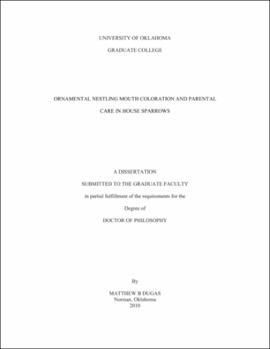| dc.description.abstract | Dependent offspring across taxonomically-diverse lineages use behavioral, vocal, chemical, and morphological traits to attract parental care. Such offspring solicitations are often hypothesized to evolve as a means of offspring-parent communication, where offspring traits furnish information about aspects of offspring phenotype of potential interest to parents (e.g., hunger, body size, immune status), and parents use these offspring traits to make adaptive decisions about the level and/or division of investment they provide. While offspring solicitations are widely interpreted as indicative of offspring "need" (more formally, the contribution that a unit of parental investment will make to an offspring's personal fitness), this interpretation seems at odds with the observation that dependent offspring solicit parental care with traits that, when found in adult animals, are typically interpreted as signals of high quality. For example, while soliciting food from provisioning parents, altricial nestling birds commonly reveal elaborately colored mouth parts, including colorful rictal flanges that border the gape. Several lines of evidence suggest that the mouth coloration of nestling birds may be a trait reflecting selective pressures imposed by reliance upon parental care. For example, flanges are present only during the nestling period, and their coloration is restricted to the portion of tissue revealed to parents during begging. I addressed the possibility that the yellow flange coloration of nestling house sparrows may serve in offspring-parent communication by examining i) the potential information content of this trait and ii) parental response to variation. I measured tissue color using reflectance spectrometry and, most often, quantified three features of flange reflectance: i) overall brightness (total reflected light), ii) relative intensity of ultraviolet reflectance (UV peak / an estimate of pigment-free reflectance), and iii) chroma, an estimate of the saturation of yellow coloration. With biochemical extractions, I demonstrated that the yellow flange coloration of nestling house sparrows is carotenoid-based, and that chroma positively reflects the amount of carotenoids present. While the maximum brightness and UV intensity of flange coloration is likely structural in origin, carotenoids limit the expression of these traits through their absorptive properties (i.e., all else being equal, carotenoid-richness is negatively associated with brightness and UV intensity). To account for this effect, I typically analyzed structural features of color with chroma included as a covariate. At days three and six post-hatching, both the carotenoid-richness and brightness (controlling for the effects of carotenoids) of flange tissue have the potential to provide parents with information about their offspring. These features of reflectance were positively associated with nestling mass, tarsus length and circulating carotenoid levels. Carotenoid-richness increased with nestling age, although brightness did not change significantly. Between days three and six post-hatching, the magnitude of ontogenetic changes in both color parameters was positively associated with the amount of mass gained by nestlings, suggesting that food intake influences the development of coloration. There was little evidence that UV coloration contained information about individual phenotype. Even after these individual-level associations among colors and other aspects of nestling phenotype were accounted for statistically (i.e., are included as covariates in models), broods were different from each other. A cross-fostering study revealed that most among-brood variation was explained by factors shared by parents breeding contemporaneously (presumably reflecting environmental variation or similarities among parents themselves); this result was consistent with seasonal differences in color revealed by the descriptive study. Carotenoid-based coloration was influenced by both pre- and post-hatching parental effects, while structural colors (brightness and UV) were not. These parental effects on chick coloration most likely result from differences in carotenoid supply (via yolk or solid food) or physiological consumption (e.g., via immune responses), although genetic differences among parents (captured by nest-of-origin effects) are also possible. In summary, within-brood variation seems likely to capture within-brood status, while among-brood variation likely reflects aspects of the conditions in which broods are reared rather than intrinsic qualities of the brood members themselves. When parents were presented with similarly-sized nestlings with mouth colors manipulated to appear carotenoid-rich or carotenoid-poor, they allocated more resources to the nestlings that appeared carotenoid-rich; this effect was significant only for females, although the trend was similar for males, and the non-significant effect likely reflected low statistical power. These preferences themselves did not indicate that parents were responding to color, in the ultimate sense, because of their information content. If carotenoid-rich colors are more visually conspicuous, parental responses might simply reflect limitations of their sensory systems. To distinguish between these alternatives, I used a model of house sparrow vision to estimate the conspicuousness of flanges under a suite of realistic ambient light conditions, and compared carotenoid-richness (chroma) to conspicuousness (contrast between the flange and interior of the mouth and the flange and nesting material). The achromatic contrast, probably the primary mediator of detectability, was either unaffected by chroma or negatively associated with this proxy for carotenoid richness, depending on ambient light conditions. Overall, these results suggest that carotenoid-based flange coloration plays a functional role in mediating the allocation of parental care, that within-brood parental preferences favor offspring of relatively high value, and that these parental preferences probably (proximately and/or in evolutionary time) exploit the information content of offspring traits to make adaptive life-history decisions. More broadly, these suggest that offspring solicitations may evolve under pressure to signal an individual's status as a promising target for future investment. | |
